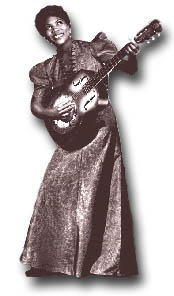Rosetta Tharpe
...was born in Cotton Plant, Ark as Rosetta Nubin in 1915 where
she grew up hearing her mother, Katie Bell Nubin, playing the Mandolin. As a
four year old..."she stood on boxes playing a guitar only slightly smaller
than herself singing "Jesus on the Main Line, Tell Him What You Want." While
there was no doubt that she had an extraordinary voice - bright and clear,
sonorous, warm, slightly brassy - and an easy delivery, she also knew at that
tender age how to sing. Her pitch was solid; she knew the melody and could
even add extra notes of her own. Her rhythm was as accented, syncopated and
intricate as any of the blues singers 'in the bottoms'"
(HOW SWEET THE
SOUND, by Horace Boyer, 1995. Pg. 154)
Rosetta was an incredible singer. But as she could sing, she was a phenomenal guitar player. She was one of the first to use the instrument as an instrument for melody-plucked lines. Her guitar playing was rich an intricate. With the exception of Memphis Minnie, no other woman gained the prominence that Rosetta Tharpe did prior to the 1930's playing the guitar.
While still a young child, Rosetta's mother began "preaching" (although women could not be referred to as "preachers" in the sanctified church.) She traveled from church to church spreading the gospel. "Her hook for drawing people to her services was 'Little Rosetta Nubin, the singing and guitar-playing miracle' " (Boyer, 1995)
In the late 1920's the Nubins moved to Chicago. Rosetta became saturated by the music that was all around her. She took every opportunity to perform. Be it jazz, blues or folk, she wanted to play. There was no doubt that she was greatly influenced by the blues singers and musicians she heard in Arkansas and the jazz that was everywhere in Chicago. But still, the church was her foundation and she continued 'singing the songs of Zion'.
 Encouraged by friends, Rosetta soon moved to New York City. On October 31,
1938, she recorded four sides for Decca Records: Thomas Dorsey's " Hide Me In
Thy Bosom," but with the title "Rock Me"; "That's All": "My Man and I"; and
"Lonesome Road." This is the first time she was billed as "Sister Rosetta
Tharpe". The first release was "Rock Me" and in addition to her guitar, she
was backed by a full orchestra (Lucius "Lucky" Millinder jazz orchestra)
(Boyer, '95).
Encouraged by friends, Rosetta soon moved to New York City. On October 31,
1938, she recorded four sides for Decca Records: Thomas Dorsey's " Hide Me In
Thy Bosom," but with the title "Rock Me"; "That's All": "My Man and I"; and
"Lonesome Road." This is the first time she was billed as "Sister Rosetta
Tharpe". The first release was "Rock Me" and in addition to her guitar, she
was backed by a full orchestra (Lucius "Lucky" Millinder jazz orchestra)
(Boyer, '95).
Rosetta Tharpe would reach superstar status in New York City. This was a 'new' sound and a new singer. But she was not without controversy. Some of the more conservative listeners, especially in the south, did not like the idea of her recording with a full orchestra and developing a "worldy" sound. She responded to the protests by asking the recording company if she could record with just her guitar. Decca did not allow her to only use her guitar accompaniment, but agreed to have just a trio with piano, bass and drum, with Samuel "Sammie" Blythe Price, a boogie-woogie musician, on piano. They began touring together. With this tour she developed a unique sound that traveled across the nation.
The church folk still weren't happy. Rosetta's love for the music was the catalyst for her to perform one week with Cab Calloway and the next in the sanctified church. Despite the controversy, she was the biggest gospel star of that time period.
In 1951, she married Russell Morrison who was the former manager of the Ink Spots. The wedding was an extravaganza. The publicity of the wedding furthered her career and her music attained an even more "secular" sound. But as her music became more "worldly," such group as the Davis Sisters, Dorothy Love Coates and the Original Gospel Harmonettes became more popular with their traditional sound and concert presentation. (Boyer)
In 1970, she suffered a stroke that robbed her of the majority of her dexterity. She passed away in 1973.
As mentioned before, Sister Rosetta Tharpe's music has influenced so many musicians all over the world (A blues-l member mentioned that even Johnny Cash was influenced by her virtuosity). The only other gospel singer to rival her world-wide prominence was Mahalia Jackson.
As many of you know, my grandmother and Sister Tharpe were "fishing partners." It is a shame that I heard the stories in detail after my grandmother's passing five years ago. There is no doubt that her life and musical contributions should be detailed in a full-length book. I sincerely hope some of you fine writers out there choose this project.
FYI: If you would like to read a comprehensive and enjoyable history of African-American gospel music, please get your hands on a copy of HOW SWEET THE SOUND, written buy Dr. Horace Boyer with outstanding photography by Lloyd Yearwood. 1995 by Elliot & Clark Publishing.
Lea Gilmore
